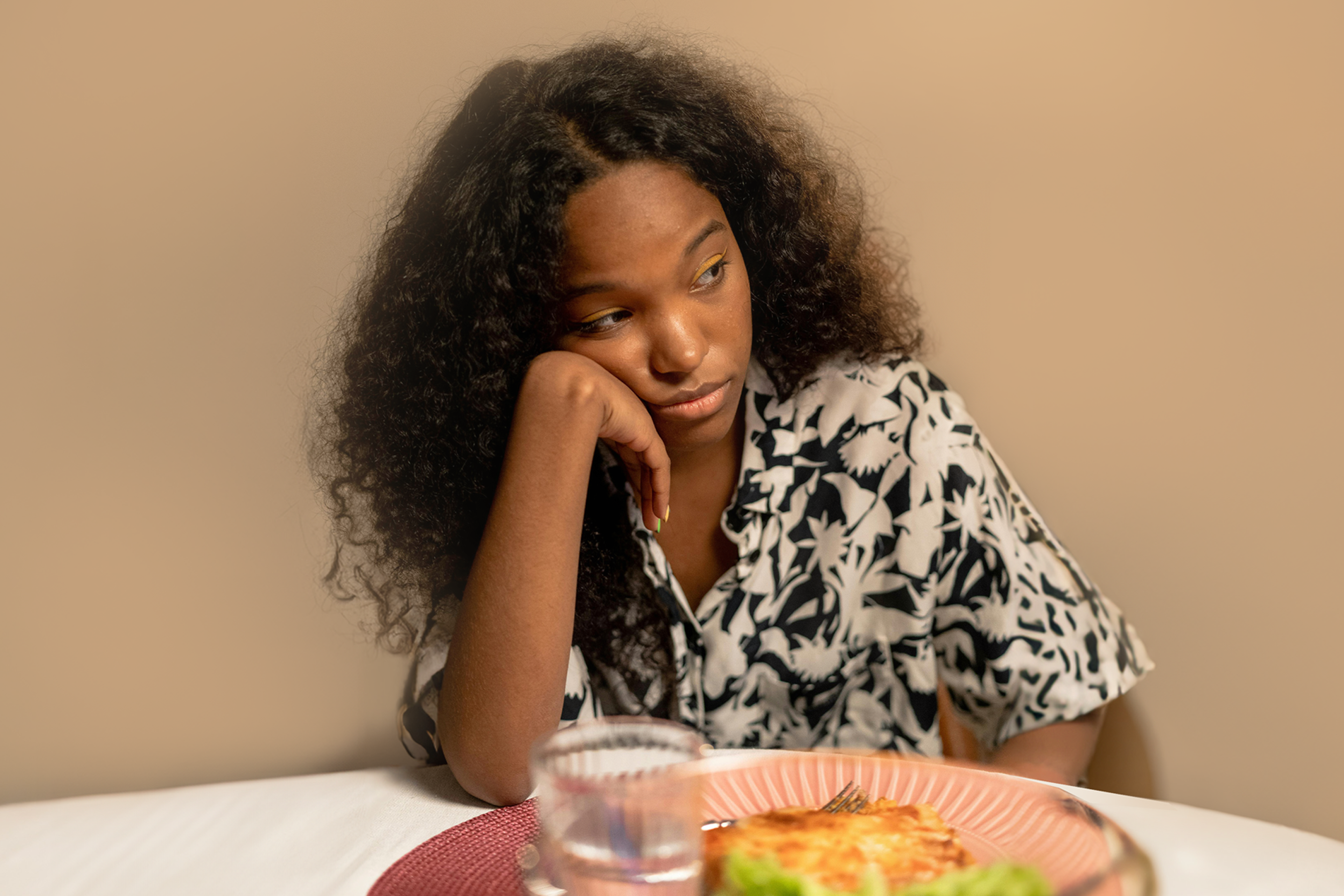

Before Equip Peer Mentor Stacy Jones was diagnosed with an eating disorder, she struggled with a related but separate issue: body dysmorphia. Body dysmorphia, also known as body dysmorphic disorder (BDD), is a mental health condition in which a person can’t see themselves objectively, and instead fixates on certain body parts or “flaws” in their appearance. “I had no idea what my body actually looked like and I felt so much anxiety from that,” Jones says. “If I didn't know how I looked, how would I know whether or not I looked acceptable to others?”
Jones says that she felt so much societal pressure to fit a specific standard that it was disorienting not to have an accurate reflection of her appearance. “This fueled my eating disorder, because I thought if I could change my body enough, I would eventually be happy with it and able to see it clearly, but this of course never happened,” she says.
Just as other psychological conditions like obsessive compulsive disorder (OCD) have been co-opted and incorrectly incorporated into mainstream language (“I like to be tidy, I’m so OCD!”), “body dysmorphia” has been misused as a synonym for body dissatisfaction. But while body image struggles can be serious and are worth addressing, body dysmorphia is different. It’s a diagnosable mental health condition, and it can be all-consuming.
Those who struggle with body dysmorphia aren’t just annoyed or upset about a perceived defect in their appearance: they can’t stop thinking about physical characteristics they deem to be imperfect, and may experience intense distress, anxiety, or shame about things that appear minor or nonexistent to others.
“I think of body dysmorphia as a distorted perception of one's body shape and size that impacts their overall self-perception,” says Equip therapist Maddie Friedman, LCWS. “It’s a brain-based issue that often results in people seeing themselves in a starkly different way than they’re seen by others.”
What causes body dysmorphia or BDD?
Experts believe that about 2.4% of the general population across all identities has body dysmorphia, and much like eating disorders, there’s no single cause; body dysmorphia results from a complex combination of environmental, psychological, and biological factors. However, there are certain risk factors that can increase the likelihood of a person developing body dysmorphia. These include:
- Negative social experiences like bullying or teasing that can heighten feelings of shame, fear, and anxiety
- A family history of the condition (or other similar mental disorders)
- Abnormal brain chemistry
- Certain personality traits, such as perfectionism
- Certain adverse life experiences
- Comparison with others
Friedman calls out this last factor as a biggie, especially in today’s media-saturated landscape. Because of how our brains work, we tend to take a more generous view of others than we do of ourselves; this is particularly true of those with body dysmorphia, and this tendency can lead to comparisons that feed into a distorted and negative self-image. “When we see others, we see them as a whole, which is vastly different from how someone with body dysmorphia sees themselves,” she says. “Something that helps with body dysmorphia is working on viewing oneself as a whole person, rather than fixating on specific body parts or physical traits.”
What are the symptoms of body dysmorphia or BDD?
Body dysmorphia can manifest in many ways, but the symptoms typically involve obsessive thoughts and body checking behaviors, often focused on the face, skin, hair, chest, and/or stomach. Some of the common symptoms of body dysmorphia include:
- Constant body checking in mirrors and/or other reflective surfaces
- Avoiding mirrors altogether
- Always comparing yourself to those around you
- Frequently asking other people for reassurance about your appearance
- Using accessories like scarves, hats, or makeup to hide parts of your body
- Grooming and/or exercising obsessively
- Seeking out unnecessary plastic surgeries to change your appearance
- Picking at your face or skin
- Refusing to leave the house and/or participate in social activities
In extreme cases, body dysmorphia can lead to severe feelings of anxiety and depression, and can even prompt thoughts of suicide.
How is body dysmorphia distinct from body dissatisfaction?
One common misconception Jones is eager to clear up is the idea that body dysmorphia is just perceiving your body as bigger than it really is. “It’s actually an inability to recognize yourself in the mirror or not being able to figure out what you look like, along with a strong fixation on certain body parts,” she says. “This happens because you only focus on one feature at a time, rather than viewing yourself as a whole. And because you’re seeing parts of your body without any context, it’s easier for the brain—which is influenced by society’s beauty standards—to warp them from what they actually look like.”
According to Equip Registered Dietitian Stephanie Kile, body dysmorphia is a brain disorder that requires effort and support to treat. “For someone with body dysmorphia, the preoccupation with and obsessive way of thinking about their body starts to impact other aspects of their lives,” she says. “This can lead to disordered eating behaviors to help ‘fix’ the areas they’re dissatisfied with.”
Friedman adds that body dysmorphia is distinct from general body dissatisfaction because it tends not to be a wholly emotional and cognitive experience, but more of a perception issue. “It absolutely can impact one's feelings and yield harsh self-critique, but I think it usually has a broader impact,” she says.
What's the relationship between body dysmorphia and eating disorders?
While not every person with body dysmorphia has an eating disorder (and vice versa), the two illnesses are, unsurprisingly, closely tied. “Body dysmorphia is often a symptom of an eating disorder,” Friedman says. “While eating disorders are genetically predisposed, they're often activated by environmental triggers. Body dysmorphia may precede the activation of an eating disorder, and may worsen as other symptoms and behaviors escalate.”
According to a recently updated paper on body image distortion, misperceptions in body image (i.e. the discrepancy between the picture you have of your body and how it actually looks) are common in eating disorders like anorexia and bulimia. One study found that out of 200 people diagnosed with body dysmorphia, 32.5% had an eating disorder.
On the other side, The Body Dysmorphic Disorder Foundation, a nonprofit dedicated to raising awareness of the condition, states clearly that BDD and eating disorders are distinct. Unlike most eating disorders, body dysmorphia usually isn’t centered on weight concerns, but an obsession with a particular body area. However, food restriction is a common tactic individuals with body dysmorphia employ in an attempt to alter their bodies.
“For some people, body dysmorphia offers an opportunity for eating disorder behaviors to creep in as a way to help the person ‘fix’ themselves,” Kile says. “It’s like the fitness industry's idea of ‘spot reducing,’ meaning if you dislike a particular part of your body you can ‘fix’ it through exercise or by removing food. In actuality, this isn’t possible, yet body dysmorphia takes hold of a particular body part and keeps saying, ‘you can change it by doing X, Y, or Z.’”
How to treat body dysmorphia
If you suspect you or a loved one are dealing with body dysmorphia, there are evidence-based treatments that can help. Experts often recommend a combination of cognitive behavioral therapy (CBT) and certain medications to help control body dysmorphia. While CBT can help you learn how to control negative thoughts and behaviors, medications can help with related mental health conditions like depression and OCD. For those who are struggling with disordered eating as a result of their body dysmorphia, normalizing eating habits can also help. “Body dysmorphia can be healed by adequate nutrition, weight restoration, and medication when appropriate,” Friedman says.
One of the most important things to understand about body dysmorphia or any mental illness is that you don’t need to have a clinical diagnosis to seek help or support. Equip’s body image program, Freeform, is a four-week virtual course in challenging societal ideals and can help participants feel more empowered in their bodies. This kind of work is crucial, considering up to 75% of people worldwide are unhappy with their bodies.
“Talking about body dysmorphia is critical, because it is so misunderstood and can have a deep impact on one's mental health,” Jones says. “Body neutrality can be very supportive through this, as well as releasing the need to meet body and beauty standards. We don't always have to know how our body looks or is perceived by others, and when we are in a more neutral place, there is space for that to be okay.”
- Phillips, Katharine A et al. “Body dysmorphic disorder: some key issues for DSM-V.” Depression and anxiety vol. 27,6 (2010): 573-91. doi:10.1002/da.20709
- Bjornsson, Andri S et al. “Body dysmorphic disorder.” Dialogues in clinical neuroscience vol. 12,2 (2010): 221-32. doi:10.31887/DCNS.2010.12.2/abjornsson
- Ruffolo, Jessica S et al. “Comorbidity of body dysmorphic disorder and eating disorders: severity of psychopathology and body image disturbance.” The International journal of eating disorders vol. 39,1 (2006): 11-9. doi:10.1002/eat.20219
- Hosseini SA, Padhy RK. Body Image Distortion. [Updated 2023 Feb 12]. In: StatPearls [Internet]. Treasure Island (FL): StatPearls Publishing; 2023 Jan-. Available from: https://www.ncbi.nlm.nih.gov/books/NBK546582/







